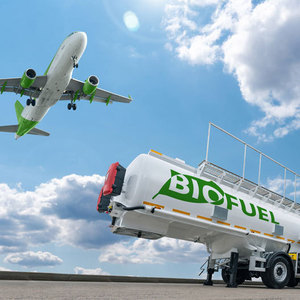SAF: Policy to Pave the Way

December 16, 2022
BY Graham Noyes and Alex Menotti
The Sustainable Aviation Fuel (SAF) Grand Challenge represents a breakthrough in federal energy policy, establishing a comprehensive strategy developed by multiple agencies to scale up new technologies and rapidly commercialize SAF in order to fully supply U.S. jet fuel demand by 2050. The International Renewable Energy Agency estimates that it will require approximately 35 billion gallons of fuel annually to achieve this goal. The first established milestone toward this is 3 billion gallons of domestic SAF production by 2030. Given that the SAF industry must scale by orders of magnitude in seven years to hit the milestone, the crucial question emerges: Is there sufficient policy to drive the rapid expansion?
The passage of the Inflation Reduction Act of 2022 provides the first indication of whether there exists sufficient will and capability in the federal government to execute on the promise of the SAF Grand Challenge. Passed by a vote of 51-50 in the Senate and 220-213 in the House of Representatives, it is fair to say that the will and capability existed in the 117th Congress by only the slimmest of majorities. However, this bare majority was sufficient to clear the first federal policy milestone, and so the industry will now benefit from five years of tax incentives. While it is unlikely that these incentives will be of sufficient duration to provide an investment signal robust enough to put the industry on track to producing 3 billion gallons in 2030, they will certainly help address existing SAF production policy and structural disincentives that have, to date, driven production of renewable diesel instead. As a result, the incentives will accelerate industry expansion and provide an essential policy building block on which the complementary initiatives from the administration’s SAF Grand Challenge, including grant funding and loan guarantees, can build.
Congress included several SAF tax incentives under the Inflation Reduction Act. The SAF Blender’s Tax Credit will be effective from 2023-’24, and is generally consistent with the existing $1 per gallon biodiesel and renewable diesel tax credits, but differs in several key respects. First, qualifying SAF need not be from biomass alone, but can be produced from nonbiogenic feedstocks like captured carbon and other waste streams, so long as SAF is not derived from petroleum or palm fatty acid distillates. In a first from Congress for fuels tax credits, the SAF BTC further adds an additional performance-based requirement that eligible SAF achieves a carbon intensity (CI) reduction of at least 50% relative to petroleum jet fuel to be eligible to receive an enhanced $1.25 per gallon credit.
Notably, Congress incentivized further reductions beyond the 50% minimum threshold by providing an additional one cent per percentage improvement beyond 50%, with SAF demonstrating a 100% reduction eligible for the maximum incentive of $1.75 per gallon. To be eligible, the SAF must also meet ASTM D7566 or the Fischer-Tropsch coprocessing provisions of ASTM D1655, Annex A, and be blended and sold in the U.S.—along with other statutory requirements.
The 50% CI reduction requirement is novel in terms of its designation of the appropriate lifecycle analysis (LCA) to apply. As industry participants are aware, there are significant and impactful variations between the LCA methodologies utilized by the U.S. EPA, the National Laboratory at Argonne, and the California Air Resources Board, to name a few. The IRA provides the following LCA criteria as the basis for meeting the 50% CI reduction requirement:
‘‘(1) the most recent Carbon Offsetting and Reduction Scheme for International Aviation which has been adopted by the International Civil Aviation Organization with the agreement of the United States,
or (2) any similar methodology which satisfies the criteria under section 211(o)(1)(H) of the Clean Air Act (42 U.S.C. 7545(o)(1)(H)), as in effect on the date of enactment of this section.”
While it is noteworthy that the U.S. has now adopted the lifecycle methodology developed for the International Civil Aviation Organization’s Carbon Offsetting Reduction Scheme for International Aviation as a methodology that can be used to qualify for a U.S. tax credit, the IRA also allows other methodologies meeting the criteria outlined in the Clean Air Act to qualify. The Argonne National Laboratory’s GREET model, EPA’s own methodology under the Renewable Fuel Standard, and potentially other methodologies should qualify based on these criteria, and the IRS recently sought comment on what methodologies beyond CORSIA should be eligible.
From 2025 to 2027, the SAF BTC transitions to the Clean Fuel Production Credit, which is also applicable to other transportation fuels, but like the SAF BTC, it provides an enhanced value for SAF. The applicable definition for SAF within the CFPC precisely tracks the prior SAF BTC definition, as do the provisions on acceptable lifecycle methodologies for SAF.
The CFPC structure is somewhat of a hybrid policy with a clean fuel standard component that may be a harbinger of future federal policies. Under a statutory formula that rewards fuels with lifecycle emissions below 50 kg CO2e/MMBtu (which also represents a roughly 50% reduction from petroleum fuels), for SAF with a 100% reduction, the CFPC would provide a credit of $1.75 per gallon versus $1 per gallon for other transportation fuels, though the incentive is considerably less generous than the SAF BTC for a reduction below 100%. For example, SAF with an 80% reduction would receive $1.09 under the CFPC, versus $1.55 under the SAF BTC. However, the CFPC contemplates crediting carbon-negative SAF beyond $1.75 a gallon, creating an important market signal for deeply carbon-negative fuels.
As noted at the outset, while these federal programs are extremely valuable to the industry and represent a policy breakthrough, standing alone, they are unlikely to be sufficient to achieve the rapid pace of the expansion set by the SAF Grand Challenge. Other elements of the IRA, including $244 million in dedicated SAF grant funding through a new U.S. Department of Transportation program and complementary clean energy tax credits, will help scale SAF, but effective policy will require long-term extensions of tax credits that are robust enough to support the vision of the SAF Grand Challenge and synergistic state policies.
The SAF producer group represented by this article’s author, attorney Graham Noyes, and that coauthor Alex Menotti, LanzaJet, actively participates in, is composed of Alder Fuels, Fulcrum BioEnergy, Gevo, LanzaJet, Red Rock Biofuels, Velocys and World Energy. This group is focused on the expansion of state SAF policies that complement federal policies. As of January 1, California, Oregon and Washington will have in place clean fuel standard policies for which alternative jet fuel is eligible to credit generation on an opt-in basis, but these policies alone do not provide sufficient incentives for SAF relative to ground transportation fuels—additional state policy support is required.
The rapid evolution of SAF policy is exemplified by an important distinction between the definition of SAF in the IRA versus the operative alternative jet fuel state definitions that are all comparable to the following California definition:
“‘Alternative Jet Fuel’ means a drop-in fuel, made from petroleum or nonpetroleum sources, that can be blended and used with conventional petroleum jet fuels without the need to modify aircraft engines and existing fuel distribution infrastructure.”
When the SAF producers, airlines and airports worked with CARB five years ago to develop the applicable definition, we were at a very early stage in the SAF policy conversation. As a result, the definition did not have a minimum threshold beyond being less than the applicable CI standard, and there was no reference to CORSIA as an eligible LCA methodology. As the SAF industry surges forward in pursuit of its 2030 and 2050 market goals, the continued expansion and evolution of state and federal SAF policy will be essential for success. Given the industry’s international nature and the lack of viable technology alternatives, the development of SAF policy and the full-scale commercialization of SAF provide substantial and unique opportunities for low-carbon liquid fuels for the foreseeable future.
Contact: Graham Noyes
Noyes Law Corp.
Fuelandcarbonlaw.com
graham@noyeslawcorp.com
Advertisement
Advertisement
Advertisement
Advertisement
Upcoming Events





